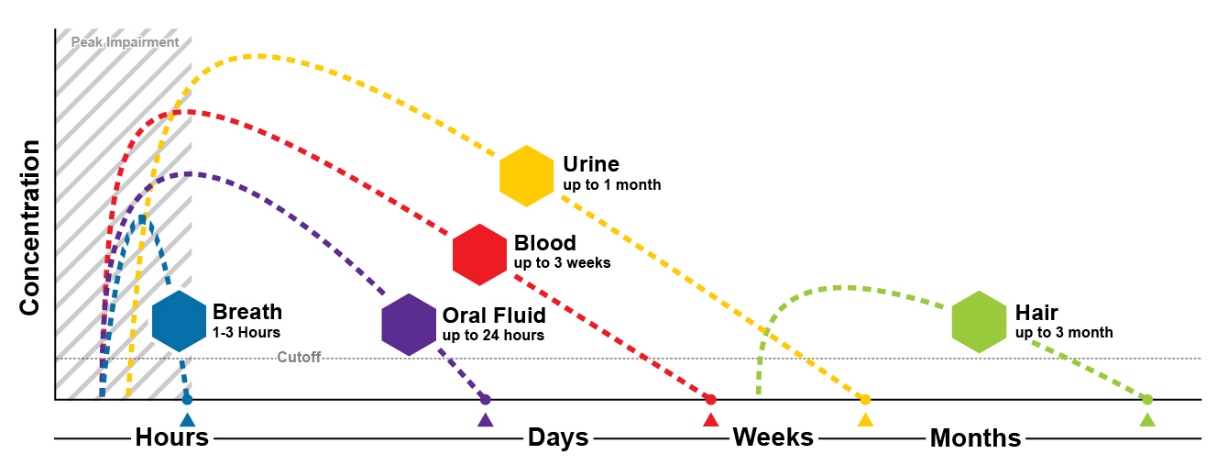Cannabix Technologies Inc. is a developer of marijuana and alcohol breathalyzer technologies for law enforcement, workplaces and laboratories. Cannabix is working to develop delta-9 THC and alcohol screening devices. Delta-9 THC is the psychoactive component of marijuana. Breath testing for delta-9 THC would allow employers and law enforcement to identify recent marijuana use. Cannabix is the developer of contactless breath alcohol detection devices for employers and other settings. Learn more about our people and technologies. Cannabix is a public company listed on the Canadian Securities Exchange
Overview
About Cannabix
The Benefits of Point of Care Breath Testing
After marijuana use, the aerosol particles in exhaled breath that are formed from the respiratory tract lining fluid contain THC and metabolites for a relatively short period of time (1-3 hours).
Whereas, it is excreted at detectable levels in other body fluids for many hours, days, or even weeks after consumption. Studies further indicate that levels of cannabinoids present in breath correlate with levels found in blood in early time points according to known pharmacokinetic metabolic pathways.

Solution for Employers
Legalization of marijuana for recreation and for medical use is growing in many jurisdictions, employers need to adapt to these new realities and develop new approaches that will support the safety of both employees and customers. Employers now need to take into consideration the consumption of marijuana before employees arrive at the job site. Current testing methods identify use from 30 minutes to 90 days prior and this is raising questions on the objectivity of such testing methods.
What is needed is a transition to fast, non-invasive, relevant “pre-access” and "post incident" workplace THC testing that can help confirm recent use of THC as opposed to detection of THC from several hours or even days ago.
Technologies being developed by Cannabix will allow for more relevant THC detection from breath allowing employers to create an onsite regiment whereby they can perform pre-access and post incident testing for recent use of marijuana.
Law Enforcement
Marijuana is the most widely used drug worldwide and, after alcohol, is the most detected substance among roadside surveyed drivers. As marijuana becomes legal in more jurisdictions, this problem will continue to grow.
Marijuana intoxication leads to cognitive and psychomotor impairment resulting in altered perception, reaction time, short term memory malfunction, attention and motor skills. Marijuana has been shown to impair performance on driving simulator tasks and on open and closed driving courses for up to approximately 3 hours. Decreased car handling performance, increased reaction times, impaired time and distance estimation, inability to maintain headway, lateral travel, subjective sleepiness, motor in-coordination, and impaired sustained vigilance have all been reported.1
In many jurisdictions, law enforcement deploy drug recognition experts (DREs) at roadside to help determine marijuana impairment. DREs conduct various observational and physical tests to assess whether someone is potentially impairment and help determine the nature of such impairment. After a series of field sobriety tests, an officer may request a saliva, blood or urine sample for analysis. Despite the complex evaluation process, the opinion of a DRE is subjective and not conclusive to determine if an accused was driving a vehicle while impaired by the presence of a drug.
When a driver’s blood sample is collected, the collection almost always occurs hours after ingestion has ceased. Often, time passes between the cessation of smoking and the beginning of driving, and more time passes between the beginning of driving and the encounter with law enforcement officials. Yet more time passes between the beginning of this encounter and the point in time when blood is drawn (often after a search warrant is obtained for driving under the influence of drugs or after the driver has been transported to a hospital post-crash). Thus, the likely THC level detectable in such a blood sample will be relatively low.2 Cannabix's handheld Breath Collection Unit (BCU) would be used collect a breath sample at the point of care, at the time of stop. This critical breath data is easily captured, sealed and labled and used for laboratory analysis using gold standard mass spectrometry via our novel Mass Spectrometer Breath Sampler (MSBS). This critical breath data would help determine delta-9 THC drug presence at the time of stop.
Current forms of testing for marijuana use, like blood, saliva and hair sample, can identify THC ranging from minutes to days after to actual use, making it impossible to show the difference between the two. Studies3have shown that THC present in breath is detectable for a relatively short period of time (1-4 hours); whereas, it is excreted at detectable levels in other body fluids for many hours, days, or even weeks after smoking. This short time period of detection in breath presents a fairer and more relevant drug screening window.
1NHSTA, 2014 Drug and Human Performance Fact Sheets
2NHSTA, 2017 Marijuana-Impaired Driving, Report to Congress
3Olla P, Ishraque MT, Bartol S. 2020. Evaluation of Breath and Plasma Tetrahydrocannabinol Concentration Trends Postcannabis Exposure in Medical Cannabis Patients. Cannabis and Cannabinoid Res.; 99-104.
Himes S. et al. 2013. Cannabinoids in Exhaled Breath following Controlled Administration of Smoked Cannabis. Clinical Chemistry; 1780–1789. Beck O, Sandqvist S, Dubbelboer I, Franck J. 2011. Detection of delta9-tetrahydrocannabinol in exhaled breath collected from cannabis users. J Anal Toxicol; 35:541– 4.

